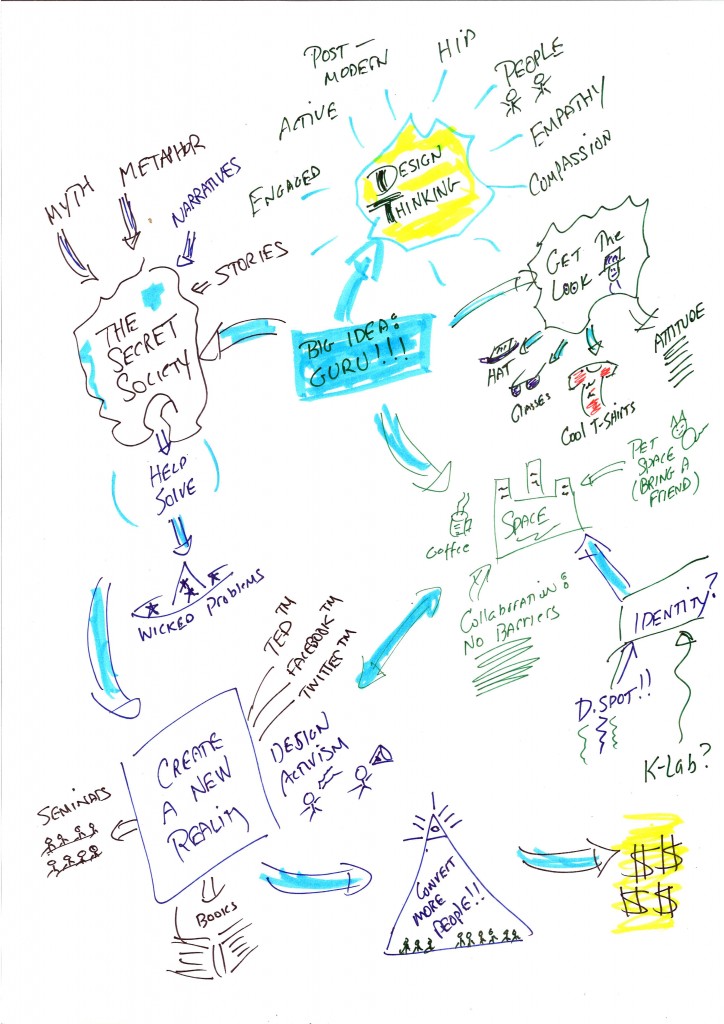According to many of my colleagues design thinking is all the rage and set to revolutionize the way we think about innovation. However, despite hearing about it a various forums, attending a design thinking in education workshop, and seeing the use of the design metaphor all around the university, I never actually could figure out what it was that distinguished design thinking from the host of other management buzz-trends that have populated the innovation space over the last three decades. So I decided to use a bit of design thinking to determine what it was that design thinking was and determined what I believe is a sure fire way to become a design thinking guru. Read further and the secrets will be revealed (book and seminars to follow).
Step 1: Look the look. From my examining various design thinking websites and engaging in some direct ethnographic observation of the design thinking crowd at my local university and elsewhere it seems that to be an effective design thinker one needs to have the look and feel of a hipster or chic geek. I am not sure that one actually needs to be a hipster (as that would, according the hipster code, be enough to make design thinking decidedly NOT hip but hipsterism does seem to have within it the seeds of its own destruction). But it is pretty clear that one needs at least a faux hipster look with a bit of pseudo science geekiness. This includes the hat, the cool devil may care carriage, the glasses, the retro bike, and other various things that suggest that you are a cool, out there, non-conventional thinker who likes nothing more than hanging out with other non-conventional types doing non-conventional things (e.g., skateboards, scooters, etc.). As to the geekiness, you cannot go too far with that as it would negate the artiness necessary to be a real design thinker guru.

Step 2: Find the locale. Design thinking appears to require its own space. Not just any space will do. Warehouses are good and certainly the first choice if available. Failing that one needs to have some place that says, we are not modern but either urban cool (hence the warehouse) or living in our own new non-linear reality (hence the potential to utilize something all wavy; green — such as vertical gardens — is also cool and hits at one of the keys of design thinging, sustainability). The space must be open and collaborative. This can be achieved easily with a warehouse devoid of conventional furniture (thrift shop sofas really fit the bill here if one is going with the warehouse look) which gives your design thinking space that dark mystic look. If you want to go with the sleek angular non-linear post modernist approach then one needs glass, lots of glass, and the zen like minimality that made Steve Job’s famous (a zen garden int the middle of the space or a Eastern water feature also would work to set the atmosphere). Whichever approach one uses the collaborative spaces must structured so cool hip types can spread out and utilize the tools of design thinking. Also, keeping with the hipster design code the locale must be urban. Suburbs are a real no-no as they smack very much of bourgeois republicanism and strip malls. Smaller towns are OK provided they are not provincial and house a world class university (think Palo Alto but not Champaign-Urbana). In addition, you need to have energy drinks and coffee. The coffee must be dispensed using some futuristic machine that says ‘I am the product of design thinking’. Energy drinks need to be available in a retro 1950s refrigerator as that just has ‘hip’ written all over it.
Step 3: Name your space. Design thinking spaces require hip names. Using the terms ‘lab’ and ‘space’ seem cool but are old hat and hence decidedly unhip given the existence of the d.lab at Stanford and various design ‘spaces’ and ‘labs’. Other alternatives include ‘pod’, anything with ‘d-‘ or ‘i-‘ in the name and the addition of random meaningless numbers — e.g., i-lab239 — or numbers linked to the address of the absolutely cool space in which the thinking is occurring. Other potential names include variants of ‘tree’, ‘open’, ‘idea’, etc. are all good. The point in the name is to sound a bit geeky and technical so that no one really gets that there is no scientific validity to what you are doing beyond a variant of brainstorming or other well tried paths to idea generation.
Step 4: Prepare your Schtick. Design thinking is all about the extraordinary. Not ordinary problems but ‘wicked’ problems. Design thinking is about patterns, metaphors, concern, empathy. Creating a new reality. So it is important to think about what your byline is and how you differentiate yourself. There are plenty of examples out there and it is important to not replicate them as that is terribly unhip (hence anything that actually uses a variant of ‘design’ in the byline is generally indicative that you have not really given the idea much thought and hence violates the precepts of design thinking). As design thinking is about tackling the ill-formed and non-linear artificial reality in which we live, you need to cover the fact that you are actually providing a very linear and structured approach that is little more than stating the obvious. You must make it appear that the acolytes are being initiated into a group that has access to special secrets. As this is a classic con, I recommend looking at the writings and presentations of such gurus as Tony Robbins and Deepak Chopra (or reading Sinclair Lewis, Elmer Gantry if you are into literature) as they have perfected the art of making money by revealing ‘secrets’ to millions.

Step 5: Acquire the tools. Design thinking is all about being out of the box and open. Hence writing paper and boards are a must (the bigger the better so that the paper can be spread out amongst the collaborators; if you are using boards they can double as walls which is a very convenient thing and also indicative of the value of a ‘design mentality’ in action). Crayons and other color pens are also important here as we need to project an image that we are not black and white but open to all of the shades of the rainbow. Other accoutrements — e.g., Foosball tables and other retro game boards — helps get the creative juices flowing.

Failing that one use the “Mythbusters” approach were the white paper is replaced with blue paper and the pens are white so that they cool and hip ideas can jump right off the paper but because all the writing is white the ideas are perceived to be more democratically equal. Additional tools include cardboard boxes, over-sized everyday items and other constructable items so that one can utilize a “Lego SeriousPlay” approach to visualization. Technology is OK up to a point as it destroys the humanistic aspect if used too much. Technology is for engineers.

Step 6: Sell the idea. At this point you have all the basic ingredients to be a successful design thinking guru. However, the important next step is to actually sell the idea of design thinking to others. Design thinking, despite its decidedly democratic ‘all ideas are good ideas’ emphasis is all about making money and making money requires others to buy in (literally). Indeed, the whole point of design thinking is not to actually design anything that is operationally workable as the idea is the thing and the way one makes money with design thinking is to get people to sign up for design thinking seminars that make them feel good about themselves (I think this is the empathy part). It is up to others to figure out if anyone can make the product or not and whether or not it can be sold (i.e., those mundane engineers and marketers). This is what distinguishes design thinking from other processes such as Quality Function Deployment (QFD), where the point of the exercise is to actually engineer something that can be produced based on an understanding of customer demand. With design thinking one is making money the old fashioned way, convincing people that you hold the magic formula for easy success. In this sense, being a design thinking guru is not dissimilar to being futurist or life coach. Design thinking gurus actually don’t need to know anything as their whole role is to engage and facilitate.
You also need to be an design thinking activist. TED seminars and other cool idea forums are great ways for you to get out and spread your ideas to those with a lot of free time to attend life altering events. However, social media and books are a must. Social media reveals that you are in touch with your acolytes. Books give you a pseudo legitimacy that comes from having ‘published’. If you can purchase a PhD somewhere so that you can add Dr. to your name that is always helpful as it gives you even more street credibility as an expert into scientific secrets.
At this point you are ready to help people attack those pesky wicked problems and help them — via a human solutions oriented empathic approach — discover the ideas that lurk just below the surface. So get those symbols and metaphors ready and begin designing. Below is a summary, using the most important tool of design thinking — the clean sheet — of the process associated with becoming a design thinking guru!
[Please note that I am sorry about the poor quality of my sheet. Unfortunately, not being artsy I do not have the ability to draw with inspirational accuracy. Also, if you have not already figured it out, this post is a parody.]


Recent Comments